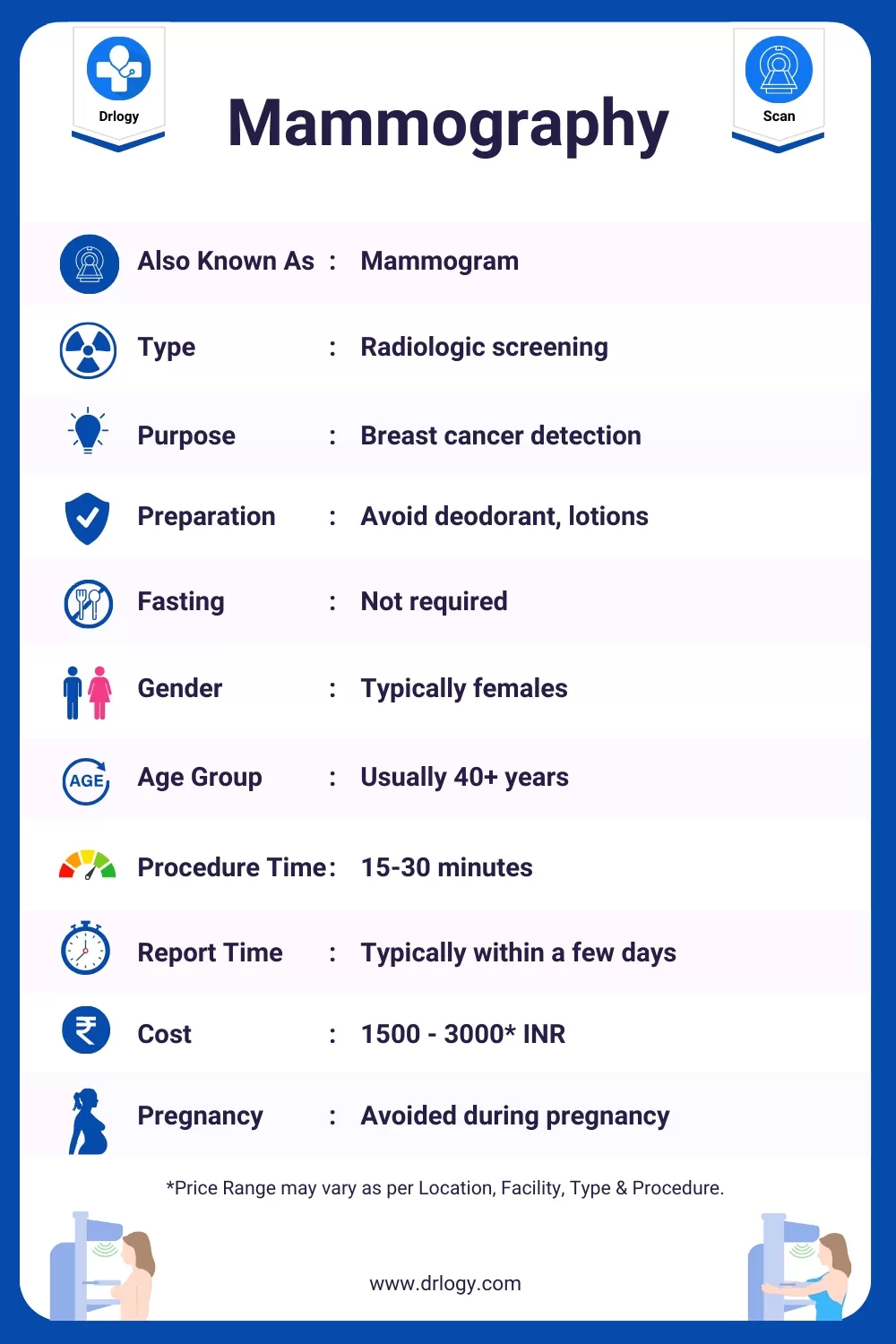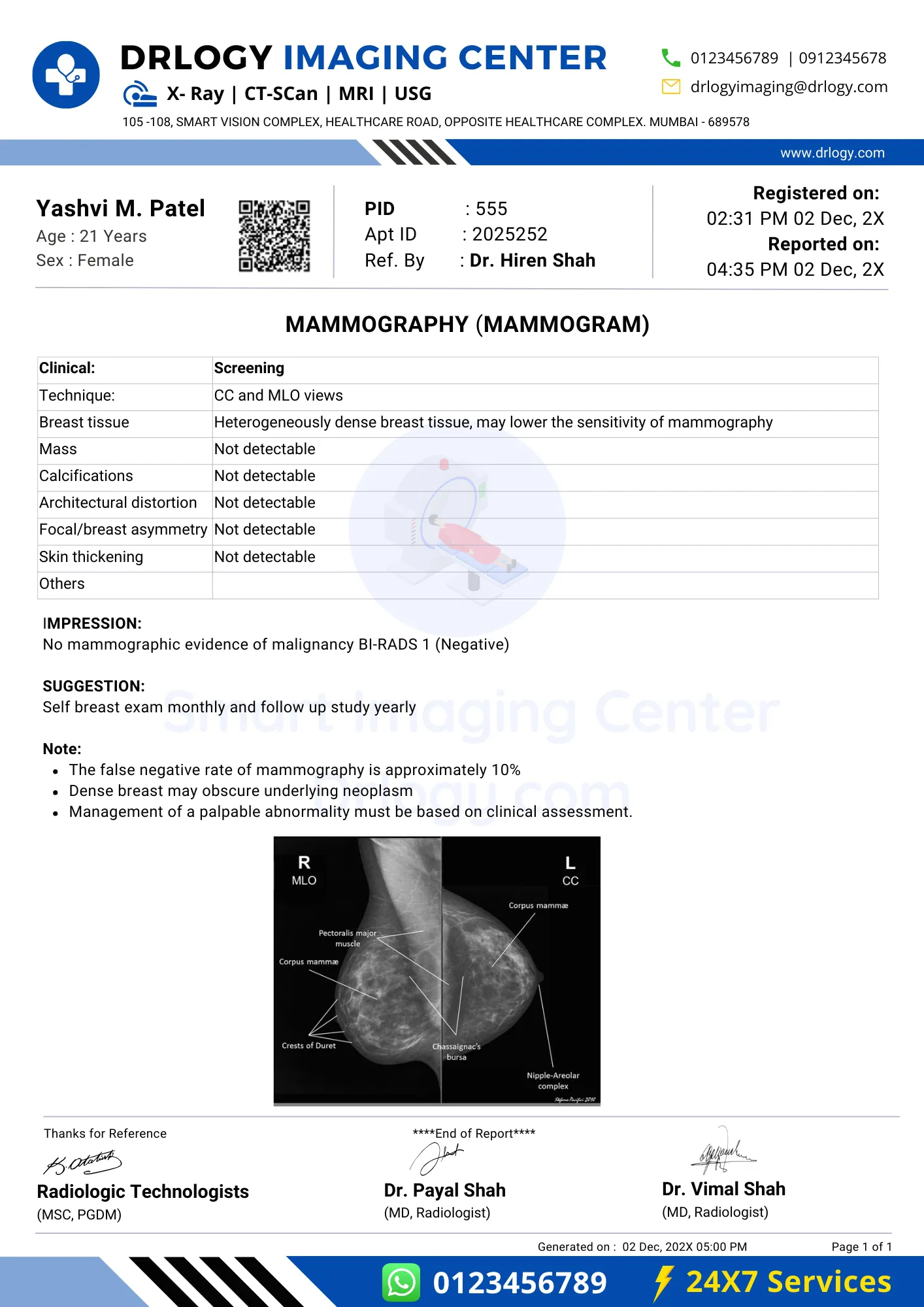
Mammography, often called a mammogram, is a breast cancer screening and diagnostic tool that uses low-dose X-rays to create detailed images of the breast tissue, helping detect and diagnose breast cancer at an early stage.
Mammography is a type of medical imaging.
Here are the basic details for the Mammography.
| Also Known As | Mammogram |
| Type | Radiologic screening |
| Purpose | Breast cancer detection |
| Preparation | Avoid deodorant, lotions |
| Fasting | Not required |
| Gender | Typically females |
| Age Group | Usually 40+ years |
| Procedure Duration | 15-30 minutes |
| Reporting Time | Typically within a few days |
| Cost | 1500 - 3000* INR |
| Pregnancy Consideration | Avoided during pregnancy |
| Risks and Safety | Low radiation exposure, generally safe |
| Accessibility | Available in medical centers |
*Price range may vary as per location, facility, type, and procedure.
Here are common reasons for Mammography.

Here are 2 main types of Mammography along with their primary use.
| Mammography Type | Organ/System | Primary Use |
|---|---|---|
| Digital Mammography | Breasts | Detect and screen for breast cancer |
| 3D Mammography (Tomosynthesis) | Breasts | Improved breast cancer detection |
These mammography types focus on breast cancer screening and detection.
Here is the basic preparation before, during, and after Mammography for any patient.
Remember that specific instructions may vary depending on your individual case and the protocols of the healthcare facility. Always follow the guidance provided by your healthcare team for a successful and safe mammogram.
| Professional | Role |
|---|---|
| Radiologic Technologist | Positions and operates the machine, and assists with imaging. |
| Radiologist | Interprets the mammogram images, and provides a report. |
The procedure for Mammography typically follows these steps:
Here are some common elements you might find in a Mammography report:
| Mammography Findings | Interpretation |
|---|---|
| Breast Density | Categories: Almost entirely fatty, scattered fibroglandular tissue, heterogeneously dense, extremely dense |
| Masses or Lumps | Location, size, shape, and characteristics of any detected masses |
| Calcifications | Description of any calcifications, such as microcalcifications |
| Architectural Distortions | Presence or absence of distortions in breast tissue |
| Asymmetries | Any observed asymmetries in breast tissue |
| Skin or Nipple Changes | Noting any skin or nipple abnormalities |
| Axillary Lymph Nodes | Evaluation of axillary lymph nodes for enlargement or abnormalities |
| Impression | Summary of key findings |
| Recommendations | Follow-up tests, additional imaging, or biopsy if necessary |
| Conclusion | Final remarks or clinical recommendations |
It's important to remember that mammography results are interpreted by radiologists or healthcare professionals, and any abnormal findings should be discussed with a healthcare provider for further evaluation and guidance.
Here's a simplified potential causes of abnormal mammography results:
| Abnormal Mammography Finding | Potential Causes |
|---|---|
| Mass or lump | Benign tumor, cyst, cancer |
| Microcalcifications | Ductal carcinoma in situ (DCIS), benign calcifications |
| Architectural distortion | Cancer, scarring, post-surgical changes |
| Asymmetry | Benign breast tissue, positional differences |
| Skin or nipple changes | Skin infection, cancer, benign skin conditions |
| Axillary lymph node enlargement | Infection, inflammation, cancer spreading to lymph nodes |
Abnormal mammography findings should always be evaluated by a healthcare provider, typically with follow-up tests or a biopsy to determine the underlying cause and appropriate next steps.
The duration of mammography can vary, but here's a general guideline for the different stages of the procedure:
| Stage of Mammography | Time |
|---|---|
| Registration and paperwork | 5-10 minutes |
| Changing into a gown | 2-5 minutes |
| Imaging process (per breast) | 5-10 minutes |
| Waiting for images to be reviewed | 5-10 minutes |
| Optional additional views | 5-10 minutes (per view) |
| Total Time (for both breasts) | Approximately 20-45 minutes |
Please note that these times are approximate and can vary depending on factors like the facility's efficiency and the need for additional views or procedures. It's a good practice to arrive a little early for your appointment to allow time for registration and paperwork.

Here are some limitations associated with Mammography.
Here are some risk factors associated with Mammography
| Myth | Reality |
|---|---|
| Causes cancer | Low radiation risk |
| Always detects cancer | Misses some cancers |
| No risk factors for false results | False positives and negatives |
| Unsafe during pregnancy | Safe during pregnancy |
Here are the estimated Mammography Prices in India with different top cities:
| City | Price Range (INR)* |
|---|---|
| Mumbai | 1500 - 3000 |
| New Delhi | 1800 - 3000 |
| Bangalore | 1500 - 3000 |
| Hyderabad | 1800 - 3000 |
| Kolkata | 1500 - 3000 |
| Pune | 1800 - 3000 |
| Lucknow | 1500 - 3000 |
| Noida | 1800 - 3000 |
| Surat | 1800 - 3000 |
| Gurugram | 1500 - 3000 |
| Patna | 1500 - 3000 |
| Chennai | 1800 - 3000 |
| Jaipur | 1800 - 3000 |
| Ahmedabad | 1500 - 3000 |
*Prices are approximate and the range may vary as per location, facility, type, and procedure.
Summary
Overall, Mammography is a valuable tool for breast cancer screening, despite its limitations and misconceptions. Also check Drlogy Test for detailed information about all medical tests for patients, doctors, scholers and medical students.
Reference
DOCTOR'S MOST TRUSTED HEALTHCARE PLATFORM
10M+Patients
30000+Doctors
25000+Hospitals/Labs